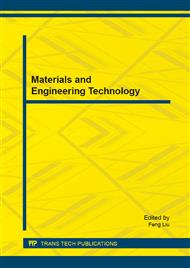[1]
C. Wu, W. Xu, Atomistic simulation study of absordeb water influence on structure and properties of crosslinked epoxy resin, Polymer. 48 (2007) 5440-5448.
DOI: 10.1016/j.polymer.2007.06.038
Google Scholar
[2]
M. Flores, X. F. -Francos, F. Ferrando, X. Ramis, A. Serra, Efficient impact resistance improvement of epoxy thermosets by adding hyperbranched polyesters parttialy modified with undecenoyl chain, Polymer. 53 (2012) 5232-5241.
DOI: 10.1016/j.polymer.2012.09.031
Google Scholar
[3]
G. Xu, W. Shi, M. Gong, F. Yu, J. Feng, Curing behavior and toughening performance of epoxy resins containing hyperbranched polyester, Polym. Adv. Technol. 15 (2004) 639–644.
DOI: 10.1002/pat.520
Google Scholar
[4]
J.D. Liu, H. J Sue, Z.J. Thompson, F.S. Bates, M. Dettloff, G. Jacob, N. Verghese, H. Pham, Strain rate effect on toughening of nano-sized PEP-PEO block copolymer modified epoxy, Acta Mat. 57 (2009) 2691-2701.
DOI: 10.1016/j.actamat.2009.02.023
Google Scholar
[5]
G. Cicala, A. Recca, C. Restuccia, Influence of hydroxyl functionalized hyperbranched polymers on the thermomechanical and morphological properties of epoxy resins, Polym. Eng. Sci. 45 (2005) 225–237.
DOI: 10.1002/pen.20242
Google Scholar
[6]
D. Zhang, X. Cheng, A. Zhang, D. Jia, Toughness and reinforcement of linear unsaturated polyester resins by unsaturated hyperbranched polymer and mechanism analysis, Funct. Mat. Letters. 4 (2011) 351-355.
DOI: 10.1142/s1793604711002202
Google Scholar
[7]
L. Boogh, B. Pettersson, J.A.E. Manson, Dendritic hyperbranched polymers as tougheners for epoxy resins, Polymer 40 (1999) 2249–2261.
DOI: 10.1016/s0032-3861(98)00464-9
Google Scholar
[8]
F. Samperi, S. Battiato, C. Puglisi, A. Scamporrino, V. Ambrogi, L. Ascione, C. Carfagna, Combined Techniques for the Characterization of Linear–Hyperbranched Hybrid Poly(Butylene Adipate) Copolymers, J Polym Sci Part A: Polym Chem. 49 (2011).
DOI: 10.1002/pola.24800
Google Scholar
[9]
P. Supaphol, N. Apiwanthanakorn, P. Krutphun, Effect of small amount of polyethylene naphthalate on isothermal crystallization spherulitic morphology polytrimethylene terephthalate, Pol. Test. 26 (2007) 985-1000.
DOI: 10.1016/j.polymertesting.2007.06.007
Google Scholar
[10]
V.P. Carvalho, C.P. Ferraz, B.S. Lima Neto, Tailored norbornene-based copolymer with systematic variation of norbornadiene as a crosslinker obtained via ROMP with alternativeanime Ru catalysts, Euro. Pol. J. 48 (2012) 341-349.
DOI: 10.1016/j.eurpolymj.2011.11.011
Google Scholar
[11]
T. Brocks, M.O.H. Cioffi, H.J.C. Voorwald, Effect of fiber surface on flexural strength in carbon fabric reinforced epoxy composites, Applied Surf. Sci. 274 (2013) 210-216.
DOI: 10.1016/j.apsusc.2013.03.018
Google Scholar
[12]
D. Santiago, X.F. -Francos, X. Ramis, J.M. Salla, M. Sangermano, Comparative curing kinetics and thermal–mechanical properties of DGEBA thermosets cured with a hyperbranched poly(ethyleneimine) and an aliphatic triamine, Thermoch. Acta. 526 (2011).
DOI: 10.1016/j.tca.2011.08.016
Google Scholar
[13]
D.M. Dhevi, S.N. Jaisankar, M. Pathak, Effect of new hyperbranched polyester of varying generations on toughening of epoxy resin through interpenetrating polymer networks using urethane linkages, Euro. Pol. J. 49 (2013) 3561-3572.
DOI: 10.1016/j.eurpolymj.2013.06.041
Google Scholar
[14]
P.G. Parchuzowski, M. Kislinska, G. Rokicki, New hyperbranched polyether containing cyclic carbonate groups as a toughening agent for epoxy resin, Polymer. 48 (2007) 1857-1865.
DOI: 10.1016/j.polymer.2007.02.021
Google Scholar
[15]
J.F. Fu, L.Y. Shi, S. Yuan, Q.D. Zhong, D.S. Zhang,Y. Chen, J. Wu, Morphology, toughening mechanism and thermal properties of hyperbranched epoxy modified diglycidyl ether bisphenol A interpenetranting polymer networks, Polym. Adv. Technol. 19 (2008).
DOI: 10.1002/pat.1175
Google Scholar


